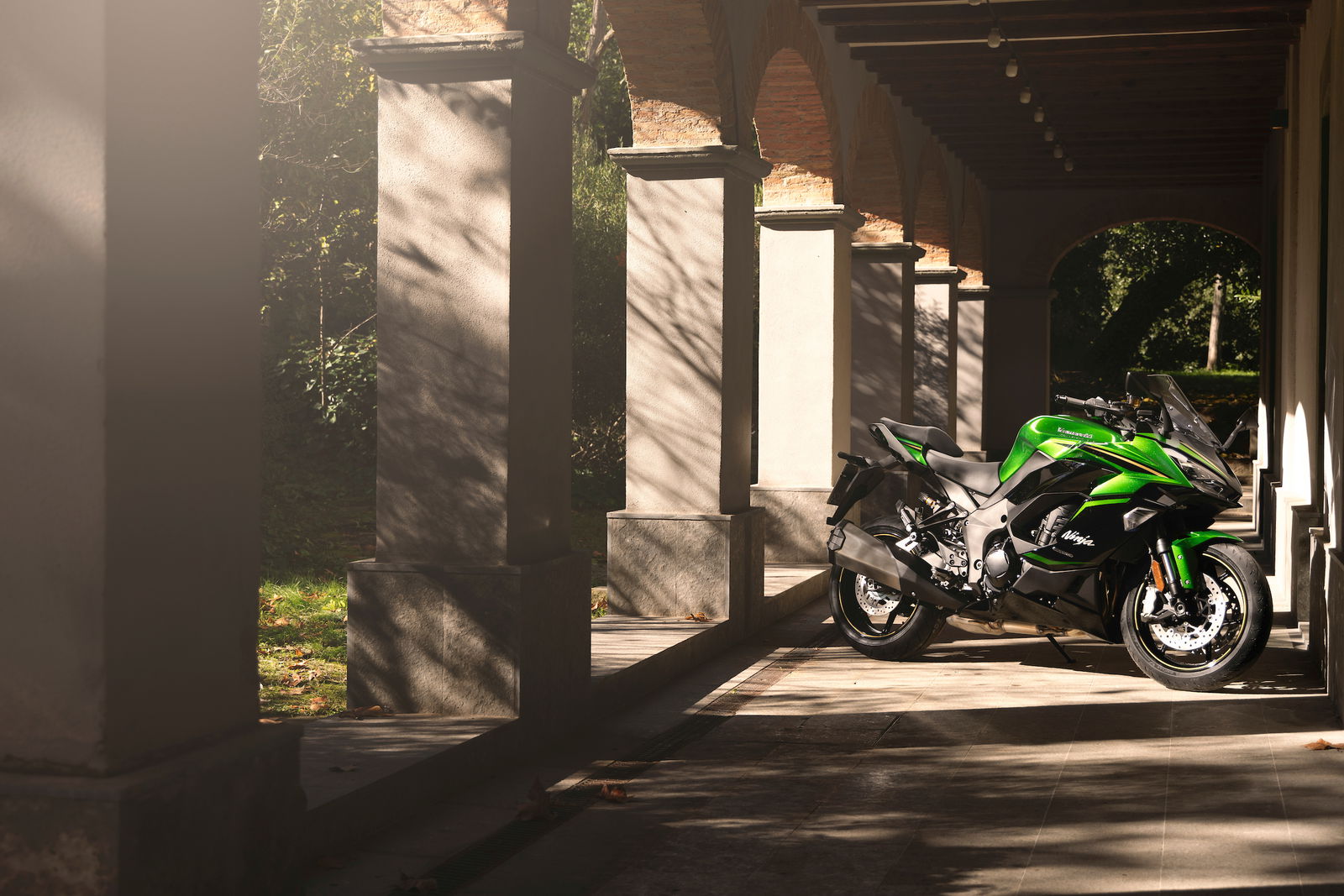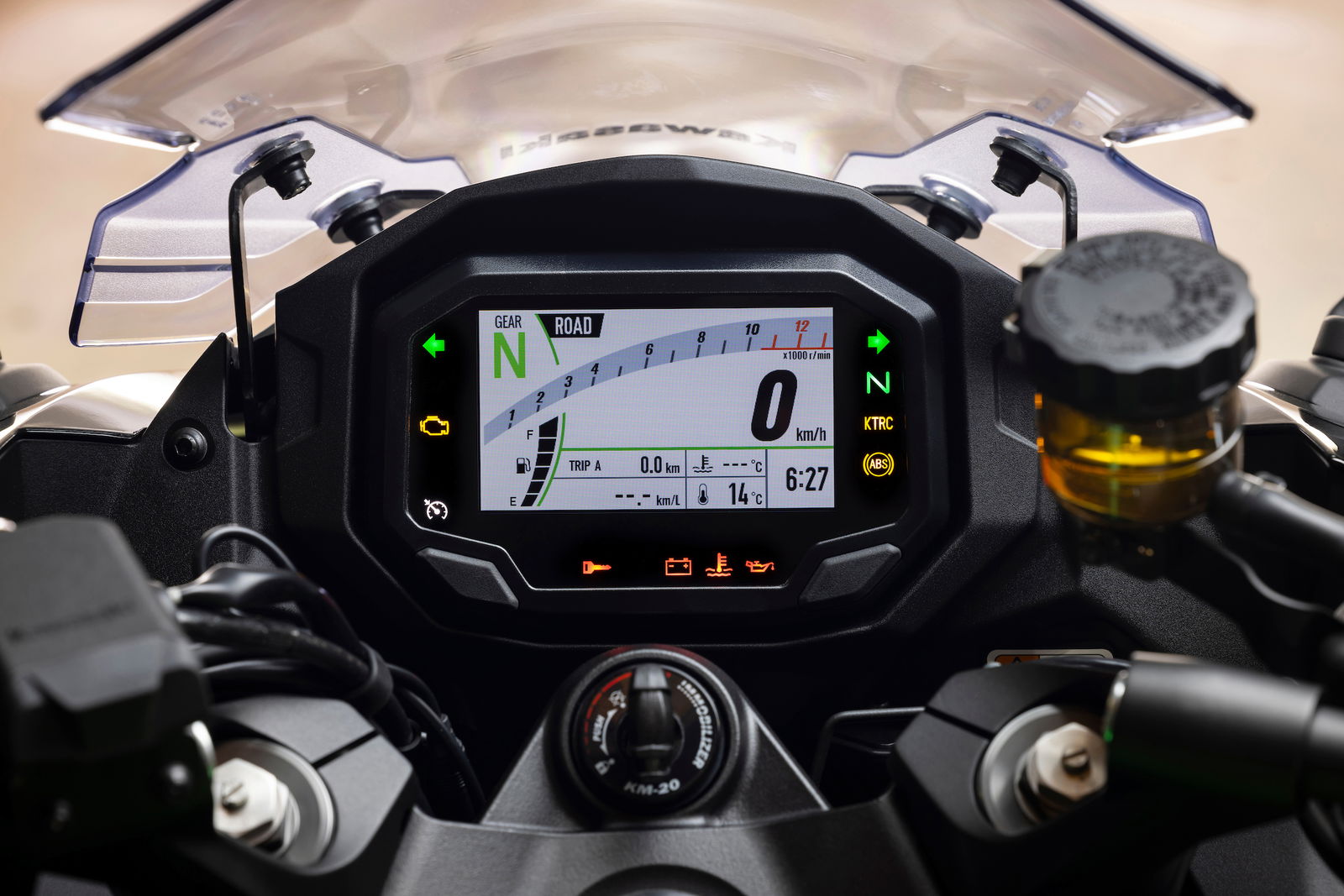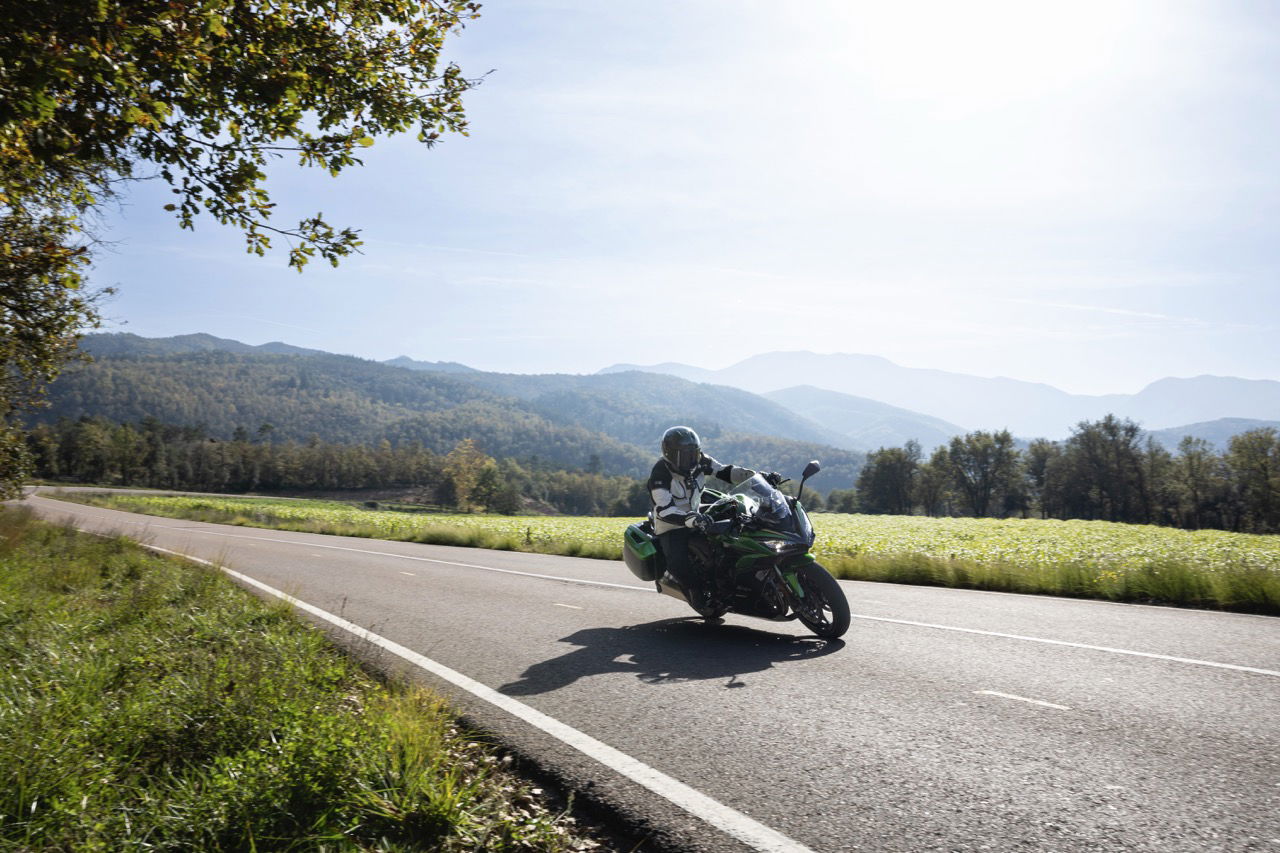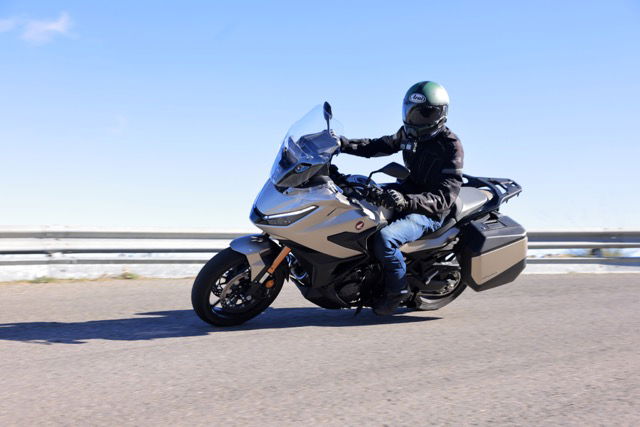2025 Kawasaki Ninja 1100SX SE Review: The Joy of SX
Kawasaki’s updated Ninja 1100SX gains a revised engine and new top-spec SE variant for 2025, boasting upgraded chassis parts

As people flock to the adventure bike sector, the pool of bikes offering a true sports touring flavour is getting ever smaller. In fact, just the Kawasaki Ninja 1100SX, Suzuki GSX-S1000GT, and BMW R1250 RS are really the only bikes from big names putting the emphasis on the ‘sport’.
Granted, there are sporty ADVs to pick from, The Tracer 9 and S1000 XR spring to mind, but they are the new breed of sports tourers, and for many the draw of an old-school take on the theme is more true way to cross a continent.
Cast your eyes then towards the new and updated Ninja 1100SX, a bike that has been Kawasaki’s biggest seller since it was first announced - then as the Z1000 SX. For 2025 Kawasaki has improved the bike thanks to a new 1,099cc engine, and also with the addition of a new range-topping SE model which gains upgraded chassis spec over the stock bike.
To see how the new SX SE version performs as a proper sport tourer, we spent a day cruising around northern Spain on the bike, covering around 130 miles during the day and taking in every kind of road you’d find when schlepping your way across Europe.

What’s new
The headline news for the Ninja 1100SX is the inclusion of a new larger capacity engine than before. It takes the DOHC, inline four-cylinder that’s also shared with the Kawasaki Versys 1100 SE we were riding a couple of weeks ago, from 1,043cc to 1,099cc thanks to an increase in stroke of 3.3mm while retaining the same 77mm bore.
Unlike in the Versys, which gains power thanks to the new powerplant, the Ninja 1100 loses out on the outgoing model, although you’ll struggle to put your finger on where the five or six horses have bolted to - peak power is now a claimed 134bhp. What you might notice, though, is a boost in mid-range and low-end grunt from the new engine. Peak twist from the engine is a claimed 83lb ft at 7,600rpm, and more torque is available through the low and mid-range, right where you need it when riding on the road.

The engine also has numerous internal tweaks, like revised intake ports, a new throttle body, revised ECU settings, new cam profiles, new pistons, increased flywheel mass (thanks to a heavier crank), and longer gearing with taller fifth and sixth gears also.
What also changes for 2025 is the introduction of a new SE variant of the bike, which gains an upgraded chassis over the standard bike. At the front, the SE gains Brembo M4 callipers mated to braided lines, a Nissin master cylinder and Brembo 300mm discs - the same KYB forks as the stock SX are retained. At the rear is an Ohlins S46 shock absorber, complete with a remote preload adjuster.
Other smaller updates appear across both of the bikes, like numerous rubber-damped vibration reducers across the frame and footpegs, and heavier bar end weights to also help smooth out the vibes. The SE also gains heated grips, while both models also come with a USB-C socket mounted (rather crudely) on the left handlebar.

Price, colours, availability and accessory packs
The stock Ninja 1100SX will land in UK dealerships in December 2024 with a sticker price of £12,249 slapped on the fairing. That price means the new 2025 edition of the much-loved machine will be only £100 more than the outgoing model at the time of the launch. The new SE model will be arriving at the same time, and the higher-spec bike will be listed at £13,999.
Colour options are Emerald Blazed Green and Metallic Diablo Black (as ridden at the launch), and a more stealthy Metallic Matte Graphenesteel and Metallic Diablo Black option.
Two accessory packs are coming to the UK, Tourer and Performance Tourer. The Tourer pack bags you a phone mount, two 28-litre panniers with internal bags, a 12v DC outlet, scratch-resistant film, a tank pad, and a large smoked windscreen. The Performance Tourer pack further adds an Akrapovic carbon end can, a pillion seat cover and frame sliders to the party. Adding the Tourer to the stock bike takes the price to £13,449, while Performance Tourer takes it to £14,549. Doing the same to the SE takes the price to £14,999 and £16,099 respectively.

What’s it like to ride?
Chilly, is how I’d sum up the start to the launch ride in Manresa Northern Spain, although as the UK is covered in snow as I ride, I’m happy the roads are at least dry and clear. Hopping on the new SX SE (the only variant we are to ride today) and everything feels very much like it did on the launch of the Ninja 1000SX I attended four years ago.

From the cockpit, there isn’t anything new to note. The dash, riding position, switchgear, and seat are all as they were. What you do notice is a bit more shove off the line. It’s not a transformative change to the bike, but it’s got a noticeably chunkier mid-range than before.
Threading through the small towns that line the route prior to our first photo stop, I’m keeping the bike in the Road riding mode and every now and again I can feel the traction control chiming in as the Bridgestone S23 hoops struggle to get any temperature into them.

Thankfully the weather rapidly warms up, and by the time we reach our photo location the road and the tyres are starting to get somewhere near optimum temperatures. It’s only really now that I start to feel like I can explore the new bike in a more fitting manner, and just like the previous version, it’s a lovely way to break the speed limit.

The new engine with its bolstered mid-range means the already fast bike is just as rapid although I’m having to work slightly less hard than before. Roll-on third-gear overtakes are less of a big deal, and despite being a few bhp down on the outgoing bike, I’m not getting the impression of a bike that is anyway underpowered. The poke it’s missing is from right at the very top of the rev range, in a place that you rarely have to go when riding on the road.

Another improved element is the noise of the thing. I don’t remember the old SX being quite this raucous, and the combination of the revised intake and internal dimensions creates a bike that is very easy on the ears.

Other than the increased grunt and new soundtrack, the Kawasaki engine is still just as deliciously good as ever. While many manufacturers look to twins, triples and V4s to power their sporty tourers, Kawasaki begrudgingly sticks to its guns with a proper big-bore inline-four, and in a bike like the Ninja, it's a move that makes total sport touring sense.

With the photo stop complete we have the best part of the day ahead, the free ride back to the hotel riding solo and following a sat nav. Freed from the group of other journos it gives me a chance to ride at my own pace and to pull over for filming or comfort breaks whenever I need to.

The route that Kawasaki has laid on for us is an absolute treat, taking in the beautiful Montseny Natural Park which was covered in fast sweepers and endless switchback hairpin bends. It’s a natural playground for the new Ninja, and what is jumping out at me is how accessible it feels once the pace rises. The KYB fork is already a very high-performing item, keeping the bike beautifully composed when braking into faster turns and soaking up mid-corner bumps like a champion.

At the rear of the bike, the Ohlins shock is doing what it does best, providing me with a supple and plush rear cushion over bumps and lumps while keeping things stable as I hammer out of slower turns. Did the big Ninja need an upgraded shock - probably not. But to me, it feels like Kawasaki has spent the development budget at the correct end of the bike, but maybe not quite on the right piece of kit. I’ve been questioning myself all day why it doesn’t have Showa’s semi-active suspension system fitted to it, as the Versys 1100 SE does. Kawasaki reasons that the price would be pushed too high if they had included it. The sceptic in me thinks it might be another reason.

One of the biggest plus points of a bike like this over and above something taller and more ADV-a-like is the handling. With its sportier dimensions and lower profile the Ninja feels faster steering and much more accurate than a longer-legged sporty tourer. It’s almost as lightfooted as a 1,000cc sports bike, although thanks to the extra weight, more relaxed front-end geometry, and softer overall setting, it is so much more planted and dependable, especially on the edge of the tyre.

Another upgraded element is the front brake, and while the Brembo M4 stoppers fitted to the SE are very good, I don’t feel that the brakes fitted to the stock SX lacked power or feel. The stocker gets Kawasaki-branded Nissin items, which were the same as the outgoing bike and unless you were heading anywhere near a race track, you’d find little to nothing wrong with them. On the SE though the stoppers have a very progressive feel, most likely down to the Nissin master cylinder, although there is ample braking power on tap. ABS is also provided in the form of KIBS, Kawasaki’s own cornering ABS function. It's barely had a chance to trigger now the roads have warmed, but on the couple of occasions it has, it’s done so in a smooth and unobtrusive manner.

It’s not all switchbacks and sweepers though, with Kawasaki chucking in some motorway stretches so we could get the full owner experience of the bike. Really there isn’t much to say about this section other than the new Ninja is beautifully stable at motorway speeds and above, and very, very comfortable. The frame, seat, bars, and pegs are also nicely free from any kind of vibes. The new taller fifth and sixth gears don’t create a feeling of an overdrive ratio as I was expecting, but for most motorway sections I’m in the sweet spot around four to four and a half thousand revs on the neat-looking TFT screen.

The screen of the bike is worth a mention, as it’s four-position adjustable but sadly that can’t be done on the fly. Both hands are required to change the angle, and one of those hands will need to fiddle about down in the faring while the other adjusts the angle. The stock screen on its highest setting is just about enough to help keep my five-foot-seven-inch frame in some sort of semblance of calm air. If you are any taller than that, the accessory taller screen will be a must-have inclusion.
On the electronics front, the SX and SE have a refreshingly small number of things you can tweak, with only engine power and traction control featuring levels of adjustability. And it’s not like there are huge amounts of change you can dial in, with three traction control levels (and the option to switch it off) and two power modes which are Full and Low power, the latter of which cuts the output to 75 per cent of the maximum.

Other electronics come in the form of the latest generation Kawasaki quickshifter (which is very good at low and high speeds), a clear and easy-to-read 4.3-inch TFT, and cruise control. You also get Bluetooth connectivity as standard, allowing turn-by-turn navigation, answering calls (with a headset), a GPS riding log (if you opt to turn it on) and Kawasaki’s new voice command. This final feature allows you to, via the Rideology app, ask the bike questions about your journey such as how long till the next fuel station. Sadly we couldn’t test this on the launch as it was awaiting final licencing and sign-off.

Should you buy a 2025 Ninja 1100SX SE?
If you are looking for a more traditional take on the sports tourer, Kawasaki’s Ninja 1100SX is still a model that can't be ignored. It’s the longest-living model in the segment for a reason, and while visually it’s little changed for 2025, beneath the skin there is enough going on to pique the interest of existing Ninja 1000 owners and those looking to ditch a wristy sports bike without losing out on thrills or performance. It’s a bike that simply inspires confidence when you ride it. The chassis, suspension, brakes and engine all work together beautifully to create a riding experience that can be as exciting or relaxed as you like.
Do I wish the bike had followed its taller sibling into the world of semi-active electronic suspension? Yes, in a way, I do. I for one would have handed back the Brembo stoppers and Ohlins shock and swapped them for the Showa electronic suspension, and I have a feeling a lot of riders would do the same. Not only is the Showa kit extremely good on the road, it also opens up changes to rear preload at the push of a button, meaning you could flick from solo riding to two-up with luggage without having to guess how many clicks of preload you require. Maybe Kawasaki is just waiting to surprise us all with an SX + model in 2025, I guess we’ll have to wait and see.

You can book a test ride on the new Ninja 1100SX and Ninja 1100SX SE here:
2025 Kawasaki Ninja 1100SX SE spec
Engine | 1,099cc, inline four-cylinder, DOHC 16 valve |
Bore and stroke | 77mm x 59mm |
Compression ratio | 11.8:1 |
Power | 134bhp @ 9,000 rpm |
Torque | 83lb ft @ 7,600 rpm |
Brakes front (SE) | Brembo M4 radial-mount four-piston caliper, 300mm discs |
Brakes rear | Single piston sliding caliper, 260mm disc |
Suspension (F) | KYB 41mm adjustable fork |
Suspension (R/SE) | Ohlins S46 adjustable rear shock w/remote preload adjuster |
ABS | KIBS cornering function |
Traction control | KTRC cornering function (switchable) |
Engine power modes | Full and Low (75 per cent of Full) |
Weight | 235kg |
Seat height | 835mm |
Fuel capacity / range | 19 litres / circa 170 miles |


